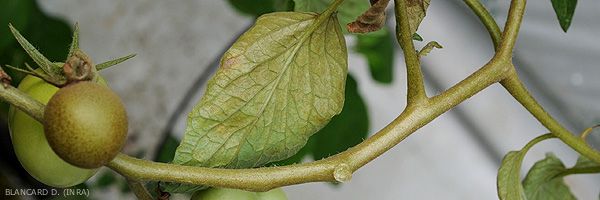
Aculops lycopersici
(tomato russet mite)
The mite Aculops lycopersici (Tryon) (figure 1), responsible for bronzed (tomato russet mite ) and a member of the Eriophyidae family, attacks several plants of the Solanaceae family: tomato, potato, eggplant, pepper, tobacco, datura, petunia . It can be found in almost all production regions in the world and in France, both in the open field and under shelters.
- Nature of damage
The undersides of the leaflets on the lower part of the plants take on a greasy to metallic tint. Subsequently, the leaves show a rather tan coloration which is the origin of the name of this disease (figures 2 to 5). Comparable symptoms can be observed on the stem on fairly large segments (figure 6), and on the petioles; flowers can abort. When the attack is not controlled, the plants scorch and dry out more or less; they can die at term (Figure 6).
Fruits are also affected. They are more or less well colored; eventually, they are often smaller and show more or less extensive corky areas (Figures 7 and 8), or even crevices (Figure 9).
These various damages are due to the nutritional bites of this mite which rapidly proliferates on the tomato.
Fruits are also affected. They are more or less well colored; eventually, they are often smaller and show more or less extensive corky areas (Figures 7 and 8), or even crevices (Figure 9).
These various damages are due to the nutritional bites of this mite which rapidly proliferates on the tomato.
- Biology
Several stages of development can be observed: egg, larval stages, and adult.
- Forms of conservation and / or alternative hosts : this mite could overwinter on various surrounding weeds.
- Stages of development : the eggs, round and white, are deposited on the leaflets and the stem. They give birth to first instar larvae, white to yellowish, having the same appearance as adults. The latter appear after the second larval instar. Conical in shape, they measure between 0.15 and 0.20 mm long and have a cream to light brown-gray or even orange color (Figure 10).
The duration of the biological cycle of Aculops lycopersici fluctuates depending on climatic conditions in particular, from less than a week to more than two.
- Dispersion in the crop : this mite, which cannot fly, is disseminated in the crop by the wind, animals and insects moving in the crop, but also workers and their tools during cropping operations.
- Favorable conditions of development : the optimal conditions of development of this mite are a temperature of approximately 27 ° C and a humidity of 30%, in other words a hot and dry weather. It also seems to adapt quite well to less clement climatic conditions.
- Forms of conservation and / or alternative hosts : this mite could overwinter on various surrounding weeds.
- Stages of development : the eggs, round and white, are deposited on the leaflets and the stem. They give birth to first instar larvae, white to yellowish, having the same appearance as adults. The latter appear after the second larval instar. Conical in shape, they measure between 0.15 and 0.20 mm long and have a cream to light brown-gray or even orange color (Figure 10).
The duration of the biological cycle of Aculops lycopersici fluctuates depending on climatic conditions in particular, from less than a week to more than two.
- Dispersion in the crop : this mite, which cannot fly, is disseminated in the crop by the wind, animals and insects moving in the crop, but also workers and their tools during cropping operations.
- Favorable conditions of development : the optimal conditions of development of this mite are a temperature of approximately 27 ° C and a humidity of 30%, in other words a hot and dry weather. It also seems to adapt quite well to less clement climatic conditions.
- Protection methods
Several protection methods are recommended to control the development of Aculops lycopersici on tomatoes in France:
- treat the plants before uprooting in the presence of high populations of pests;
- remove and destroy plant debris and crop residues;
- leach with water and treat the walls of shelters , posts, concrete walkways with an insecticide or a contact acaricide ( link e-phy );
- disinfect the equipment used in the greenhouse (drip system, boxes );
- check the sanitary quality of the plants before and during their introduction into the shelter;
- weed the greenhouse and its surroundings;
- consider chemical protection ( e-phy site ) *, in particular if you use auxiliaries (no auxiliary can be used to control the development of Aculops lycopersici ).
- treat the plants before uprooting in the presence of high populations of pests;
- remove and destroy plant debris and crop residues;
- leach with water and treat the walls of shelters , posts, concrete walkways with an insecticide or a contact acaricide ( link e-phy );
- disinfect the equipment used in the greenhouse (drip system, boxes );
- check the sanitary quality of the plants before and during their introduction into the shelter;
- weed the greenhouse and its surroundings;
- consider chemical protection ( e-phy site ) *, in particular if you use auxiliaries (no auxiliary can be used to control the development of Aculops lycopersici ).
* Chemical control : As the number of pesticides available for a given use is constantly changing, we advise you to always confirm your choice by consulting the e-phy site of the Ministry of Agriculture and Fisheries which is an online catalog of plant protection products and their uses, fertilizers and growing media approved in France. This also applies to all biological products based on microorganisms or natural substances.





